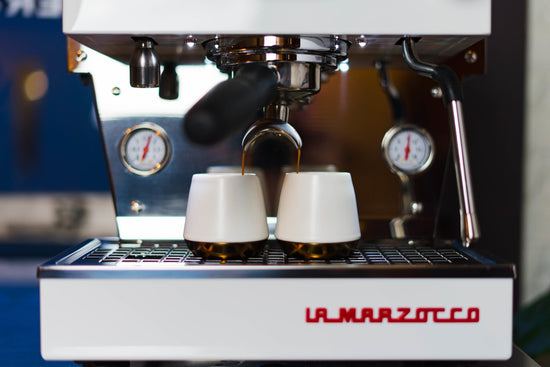Even Extraction - The Pursuit of Perfection

This article borrows heavily from work done by Chris Baca of Cat & Cloud and Matt Perger of Barista Hustle.
We have written at length on how extraction works and the science behind what is happening in the coffee bed. This is all important to truly understand how to optimize your espresso at home or in the cafe. However, there is one stone that we have left unturned to date. How to achieve even extraction.
What is "Even Extraction"
An even extraction is the result of a three-step process for 1) dosing your coffee correctly from your grinder, 2) distributing your coffee in the portafilter, and 3) even, consistent tamping. To start, we'll re-emphasize some classic fluid dynamics wisdom.
Water will always choose the path of least resistance.

So, we start with a basket of freshly ground coffee tamped and inserted into the group head. Suppose it has been evenly distributed and tamped. In that case, the density of the coffee grounds will be identical throughout the basket, meaning that all of the grounds will have the same interaction with the water (both time and pressure). Remember that pressure is a measure of resistance, so an uneven distribution of coffee will also lead to varying pressure across the puck. But let's keep this simple.
If the distribution of particles is uneven, water will flow at different rates through the bed of coffee. In this example, the right side of the portafilter is more densely distributed than the left. Therefore, the coffee will be over-extracted from the left and possibly under-extracted on the right. Either way, it's not good and usually leads to a sour espresso.

This type of uneven extraction is relatively common among new baristas. Something as simple as roughly handling your portafilter will cause the puck to distribute the grounds unevenly. The biggest challenge with a defect in particle distribution is that it is a hidden problem. The same volume of espresso may extract at the same time as an evenly distributed puck, but it will taste very different. That is why we recommend bottomless portafilters. Bottomless portafilters will allow you to see the different rates of extraction and the telltale signs of channeling. You have some uneven extraction if your espresso machine is a splattered mess after pulling a shot with a bottomless portafilter. The water is finding a path of less resistance and spraying out of it.

How do I evenly distribute my coffee?
There are more opinions about coffee distribution than wealth distribution, and those that argue the virtues of each are just as passionate! Our opinions are highly informed by teaching individuals how to achieve consistent results and by work done by Matt Perger at Barista Hustle. He has done some excellent analysis of distribution techniques here, but we will summarize them for you.

The Grinder
First, we need to set ourselves up for success at the grinder level. Distributing the coffee evenly in the portafilter from the grinder is one of the easiest ways to get great results. If you grind into one side of the portafilter - it will be tough to distribute that coffee evenly—even if you follow the tips below. Below is a shot of Victoria evenly distributing from a Eureka Zenith grinder into a triple basket 58mm portafilter.

The Distribution Technique
Matt researched the following techniques: Side to side and vertical tapping, the Stockfleth method, or just tamping right out of the grinder. He found that the side-to-side and vertical tap yield a more consistent distribution. We encourage you to try the tap method as well as the Stockfleth. Both take much practice but will yield consistent results if done correctly. The key here is to ensure that the entire basket is filled evenly with grounds, all the way to the sides. Those are the most common problem areas of under-extraction.
Another method we've become big fans of around the office is using a simple distribution tool. Our tool of choice is the Wedge by Saint Anthony Industries. Simply spin the tool atop your fresh grounds, and it'll evenly spread them around. The depth is adjustable to ensure this is done gently. While we wouldn't venture to say that a distribution tool is necessary, they make getting consistently even distribution a breeze. Lastly, we love the WDT method. These tools are excellent for removing clumps from coffee grounds and distributing the entire coffee bed.

How to Tamp
How many opinions can there be about as simple an action as pushing coffee grounds? At Clive, we prefer to keep it simple. Hold the tamper like you would hold a doorknob and evenly tamp it using enough pressure that you have to put a bit of shoulder into it. Ultimately, it should feel like pushing strongly against a flat counter. Consistency is more important than having a specific amount of pressure, so don't hurt your wrists. However, the real key is ensuring your tamp is perfectly level. If it is tamped even at a slight angle, it will create an area of uneven distribution and a path of less resistance. Remember, the technique he recommends is for professional baristas who have to do this hundreds of times a day. For the home user - just focus on straight.

If you want a tool to help ensure your tamp is level and consistent, we recommend the Levy by Saint Anthony Industries. Like the wedge, the Levy tamper can be calibrated for depth, and its collar ensures a level tamp every time.
If you need more tamping help, check out how to Perfect Your Tamp Skills on our blog. Once you nail it all - you can start to work on replicating the cafe at home. Check out Espresso Drink Recipes on our blog post if you want to look at some of ours.
For a deeper dive into espresso theory and training, check out Intro to Espresso now available through Coffee School.